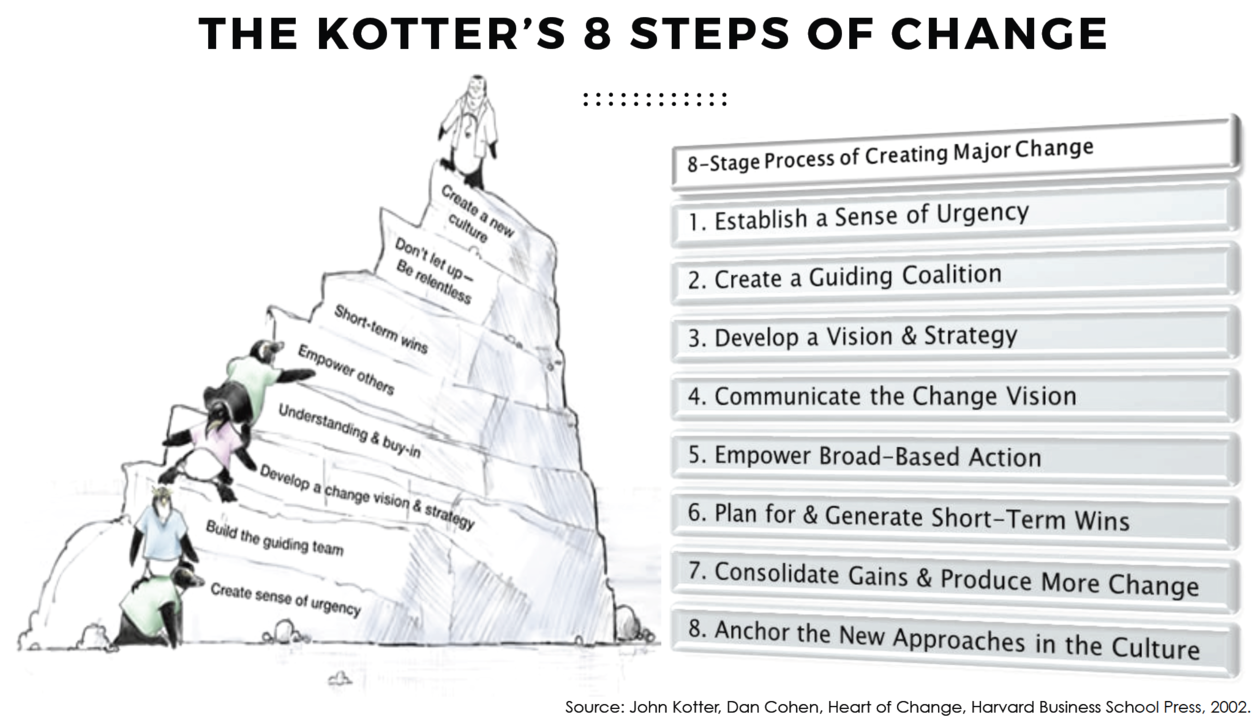
How to make your next digital transformation project successful
Harvard Business School professor John Kotter is widely considered the leading expert on managing transformational change projects. He says to achieve lasting change, you need to take into account how people accept, engage with, and maintain it.
Kotter’s eight steps of change provide a clear path to get there. Read on to learn how to successfully apply his framework to lead your next digital transformation project.

How to improve your forecast accuracy - with psychological safety
Even the most complex forecasts are done by people. And in the end, people do what’s best for them. Even if that’s at odds with the interests of the company. To prevent that, you need to foster “psychological safety”. Read on to learn what it is, what you can do today to improve it, and as a result, your forecast accuracy.

The four pillars of successful Digital Transformation
Digital Transformation means you use data, not intuition. It requires people to use data to generate insights, which eventually lead to faster action and improved results. But it’s not as simple as implementing the latest software. Read on to learn how Finance leaders can make a difference.

How to measure Return on Marketing Investment correctly
Knowing the effectiveness of your marketing tactics is critical - especially if your company is running campaigns on multiple channels at the same time. Unfortunately, getting accurate results in this scenario is tough. Here are two ways to get there.

How to develop your influencing skills
Influencing skills are important not just for FP&A leaders but for anyone who has to convince others to achieve their goals. Here is some concrete and easy to apply advice on what you can do today to grow your influence.

The future of data-driven decision-making according to McKinsey
Two McKinsey partners extrapolated the future of how companies will use data in 2025 based on their extensive experience in the field. This article summarized the main points of their work.

A simple way to improve the month-end close process
Month-end close can be a stressful time. Most people spending any amount of time running it can tell stories of last-minute sprints and near misses. But it doesn’t have to be that way. Here is a simple tip to make the close easier for everyone involved.

Why creating annual budgets isn’t a waste of time
Running an annual budgeting process takes a lot of time. It can tie up the entire company. So it’s important the time put into it is made to good use. Spending it all on getting the highest accuracy possible doesn’t make sense. Read on to learn what you should focus on instead.

Make your financial presentations more engaging
When we present the financials, we don’t want people just to sit there and listen. We want them to use what we give them to drive the business forward. If we are not engaging, the likelihood that this will happen goes down dramatically. In this post, I’m sharing some concrete advice on how you can become a more captivating presenter.

Why you need “50/50” forecasts - and how to create them
Debiasing your forecasts is critical for optimizing forecast accuracy. The 50/50 forecast is a framework to get there. Read on to learn how to create one.

How to speed up variance analysis
Analyzing what caused variances between forecast and actuals is a crucial element of most FP&A roles. That’s because if done well, it can unearth significant risks or opportunities. If you don’t have time to understand the reasons, though, you’ll only scratch the surface of what you can do. So here are 3 tips for doing variance analysis more efficiently.

How FP&A Analysts lead top-down revenue forecasting
Forecasting best practice is to prepare a top-down and a bottom-up version and use them to find the most accurate point on the range through iteration. In this post, we go deep into how top-down forecasts work.

The 9 habits of high-performing Financial Analysts
To differentiate yourself from your peers, doing well at your core tasks isn’t enough. There is more you can do if you want to accelerate your career. Here are some ideas that I’ve seen work.

First Principles of FP&A
There is a secret to how Elon Musk was able to learn how to build rockets from scratch and beat NASA and other government organizations at their own game. It’s “reasoning from first principles”. Let me walk you through how it works and how FP&A managers can apply it.

How a journal helped me get promoted to FP&A Manager
You may be getting great feedback on your performance, you are motivated, you are putting in the extra hours, but - you aren’t getting promoted. What may be missing is that you haven’t yet moved the needle. You haven’t yet done something in your role that has a lasting impact. I’d like to share a piece of advice I received from my mentor that helped me achieve it.

How FP&A Leaders use “premortems” to identify risks
Many projects fail because people aren’t prepared for failures. Fortunately, there is something FP&A can do about that. “Premortems” work because they create a safe space to share concerns. As a result, blind support for ideas gives way to creative problem-solving. Read on to learn what they are and how to use them.

4 ways you can demonstrate leadership as an FP&A Analyst
To get promoted as FP&A Analyst, you need to show you can lead. Outstanding performance at your core tasks isn’t enough. Here are 4 ways you can demonstrate leadership.

3 ways Financial Analysts deal with uncertainty in a forecast
You can’t treat every forecast the same. More uncertainty means more risk. And Financial Analysts tend to create forecasts that are riskier than they need to be. Here are three things you can do when you have to create a forecast without a lot of hard data.

Do you know you are dealing with politics as an FP&A Analyst?
Politics means people do only what’s best for themselves. Here are 3 common issues and what to do in each situation.

How to effortlessly manage large Financial Models
When it comes to Financial Modeling, the structure is everything. Keep reading to learn how to make your models more organized and easier to handle.
